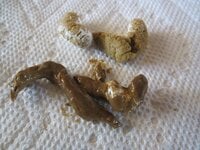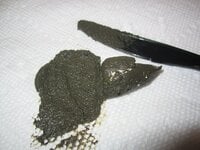Cecal vs regular poop.
I think this explains the ceca pretty well:
"by Wendy EN Thomas of Lessons Learned from the Flock
For those of us who have never seen the inside of a chicken, it turns out that a chicken’s anatomy is pretty darn interesting. I recently took a class where poultry anatomy was explained and although there are many interesting bits throughout a chicken’s digestive and reproductive systems, today I am going to concentrate on two tiny sacs that help with digestion.

Located at the at the ileo-colic junction (the end of the small intestine) and before the beginning of the large intestines are the cecal pouches. These little pouches or sacs are analogous to the cecum in mammals except that with chickens, there are two. (Makes sense, chickens proportionally eat a lot more fibrous material that needs to be broken down than mammals do.)"
So how do these sacs help chickens with their digestion? The main purpose of cecal pouches is to collect fibrous material from the small intestines. While this material is being held, the cecal reabsorbs as much water as possible, while at the same time fermenting and breaking down the coarse material that the chicken has eaten (twigs, fibrous materials.)
The cecal pouches then expel and empty that fermented, partially-dehydrated mess two to three times each day.
Here’s the tricky part and what you really need to know about cecal pouches. The droppings from the cecal appear much different than the normal intestinal poultry droppings. A regular normal chicken dropping is firm, green to brown in color, and had a bit of white urate deposit.
A normal cecal dropping, on the other hand, is a brown, soft, moist dropping with a strong odor. A dropping that sometimes causes some chicken owners alarm as they mistakenly think it is an indication of diarrhea and illness.
Thick, sticky, brown chicken droppings will occur on a daily basis. It’s important to identify these and recognize that they are normal dropping as a result of chicken’s having those cecal pouches."
Below is my contribution to this artcile
Cecal poop vs regular poop
These are overnight poops from a 7-year-old rooster that appears to be quite healthy. On the left is a normal cecal poop, on the right, are pretty normal regular poops, though one pile has a little spec of red.

This is the same poop moved to a paper towel. regular poop on top, cecal on the bottom.

Same poop again. Notice the creamy texture of the cecal poop compared to the regular poop. Interestingly, I think maybe I can see a cecal worm in this picture.

Normal peafowl cecal poop:


Abnormal peafowl cecal poop:

I think this explains the ceca pretty well:
"by Wendy EN Thomas of Lessons Learned from the Flock
For those of us who have never seen the inside of a chicken, it turns out that a chicken’s anatomy is pretty darn interesting. I recently took a class where poultry anatomy was explained and although there are many interesting bits throughout a chicken’s digestive and reproductive systems, today I am going to concentrate on two tiny sacs that help with digestion.

Located at the at the ileo-colic junction (the end of the small intestine) and before the beginning of the large intestines are the cecal pouches. These little pouches or sacs are analogous to the cecum in mammals except that with chickens, there are two. (Makes sense, chickens proportionally eat a lot more fibrous material that needs to be broken down than mammals do.)"
So how do these sacs help chickens with their digestion? The main purpose of cecal pouches is to collect fibrous material from the small intestines. While this material is being held, the cecal reabsorbs as much water as possible, while at the same time fermenting and breaking down the coarse material that the chicken has eaten (twigs, fibrous materials.)
The cecal pouches then expel and empty that fermented, partially-dehydrated mess two to three times each day.
Here’s the tricky part and what you really need to know about cecal pouches. The droppings from the cecal appear much different than the normal intestinal poultry droppings. A regular normal chicken dropping is firm, green to brown in color, and had a bit of white urate deposit.
A normal cecal dropping, on the other hand, is a brown, soft, moist dropping with a strong odor. A dropping that sometimes causes some chicken owners alarm as they mistakenly think it is an indication of diarrhea and illness.
Thick, sticky, brown chicken droppings will occur on a daily basis. It’s important to identify these and recognize that they are normal dropping as a result of chicken’s having those cecal pouches."
Below is my contribution to this artcile
Cecal poop vs regular poop
These are overnight poops from a 7-year-old rooster that appears to be quite healthy. On the left is a normal cecal poop, on the right, are pretty normal regular poops, though one pile has a little spec of red.
This is the same poop moved to a paper towel. regular poop on top, cecal on the bottom.
Same poop again. Notice the creamy texture of the cecal poop compared to the regular poop. Interestingly, I think maybe I can see a cecal worm in this picture.
Normal peafowl cecal poop:
Abnormal peafowl cecal poop:








